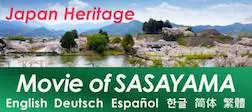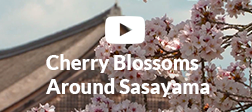Experience Samurai Life at the Anma Family Residence
The Samurai Residence Anma Family Museum was formerly a samurai residence, or bukeyashiki, constructed within the surroundings of Sasayama Castle. The residence underwent repairs between October 1994 to March 1995 and now tells history as a museum.
The Anma Family Museum is in a house constructed in a residential area for samurai called Okachimachi. Tableware and furniture made in the Edo period (1603 – 1868), armor, remaining archives, the L-shaped Magariya main building with a thatched roof, and the warehouse with a tile roof offer glimpses of samurai life at the time.
The Anma Family Residence was largely destroyed by a fire in 1830. After the fire, the estate was moved back from the road by six shaku (approximately 1.8 meters). As a preventive measure, an area that protects the structure from fires was created upon reconstruction. Even now, however, traces of the fire disaster are visible between the road and earthen walls.

Highlights of the Anma Family Residence
The most impressive feature of the residence is how carefully its appearance has been preserved. During the Abolition of the Domain System, an administrative reform during the Meiji period (1868 – 1912) when the transfer of retainer samurai occurred frequently, there were few transfers from Okachimachi. As the people had not left, the residence was well maintained. Guests can grasp the original characteristics of the estate, from the layout of the rooms to the scale of the residence.
Be sure to notice the Tamba suikinkutsu located in the courtyard. A suikinkutsu is a device that makes the sound of water reverberate throughout a Japanese garden. A jar buried underground that creates an echo of the sound of dripping water.
The Tamba suikinkutsu is Tamba pottery, which is one of the six oldest ceramic-making methods in Japan. You can feel the elegant way of life of the Edo Period from its soothing sound.
The Okachimachi Samurai Residence is one of the Important Preservation Districts for Groups of Traditional Buildings. How about stepping into the wonderful historical scenery of a castle town and traveling back to the Edo Period?

Samurai Residence Anma Family Museum - Information
Address: Sasayama, Nishi-shinmachi 95
Phone: 079-552-6933
Website: http://www.withsasayama.jp/REKIBUN/anma_top.htm
Access: 15-minute walk from the JR Fukuchiyama Line at Sasayamaguchi Station, exiting at Nikaimachi bound for the Shinki Green Bus Sasayama Business Office
Fee: 200 yen for adults, 100 yen for high school and university students, and 50 yen for elementary and junior high school students.
Holidays: Mondays (open on national holidays and closed the following day), December 25 – January 1



